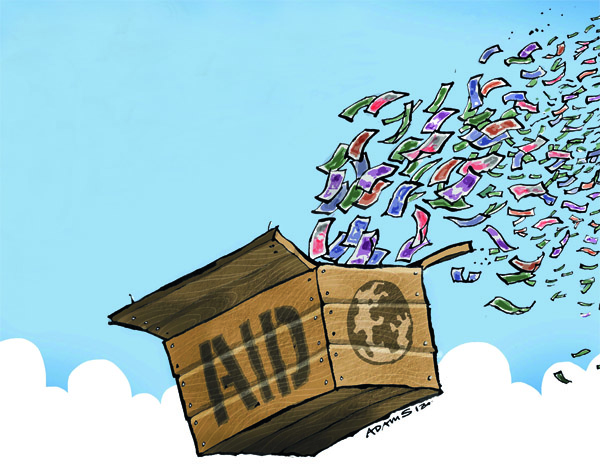
For foreign observers, Chinese foreign aid is a surprisingly difficult area to study and understand. This is not just because China does not follow the traditional OECD definition of foreign aid. But more importantly, it is due to the fact that foreign aid data is as tightly guarded as state secrets by China, and country-specific information, such as the volume, the purpose, the priorities and the terms of foreign aid, all remains in a tight black box. In liberal democratic countries, government budgets, including foreign aid spending, are subject to clear, mandated legislative supervision and public monitoring. Furthermore, there is a prevailing belief that foreign aid is a useful/effective tool to promote a positive image of the donor country, therefore aid is often exhaustively promoted. The combined effect of this is that many westerners find China’s secrecy perplexing.
To understand Chinese foreign aid policy first requires an understanding of the complex goals China tries to achieve with aid, and secondly, of the complex intended or unintended effects after the aid decision is executed. In the Chinese foreign policy lexicon, foreign aid is defined as an instrument to advance China’s comprehensive national interests. There are at least four categories of interests China pursues through foreign aid.
Politically, foreign aid serves to consolidate political friendship between China and the recipient countries. The issue of Taiwan is a good example: China has adeptly implemented checkbook diplomacy to compete for diplomatic recognition of One China policies by less developed countries, especially those in Africa. In certain countries that China enjoys special strategic relations with, such as North Korea and Pakistan, Chinese foreign aid helps to prop up the governments and provide for the population’s economic needs, to compensate for the recipient government’s failures. Economically, foreign aid (especially the concessional loans) has been widely used to sweeten the commercial deals China has pushed in the receiving countries. China uses its foreign aid budget to make up for the differences between concessional interest rates and commercial interest rates for the projects’ loans. According to the “Foreign Aid White Paper” China released in 2014, 55.7 percent of China’s cumulative foreign aid has been used on concessional loans, much higher than the combined total of grants (36.2 percent) and zero-interest loans (8.1 percent).
Beyond the tangible political and economic interests, Chinese foreign aid also has soft power goals. Chinese foreign aid has played an important role in enhancing China’s international image by demonstrating China’s growing effort to fulfill its international responsibility to peace and development, as a great power. Last but not least, as the capacity-building component of China’s foreign aid has kept growing in recent years, Chinese foreign aid also serves to promote China’s “development and governance experience” in less-developed countries, through training programs for decision-makers, government officials and party cadres. Although this may not qualify as an “export of ideology”, China’s effort to promote the “China Model” in fragile states and developing countries is more than conspicuous.
Grand and glorious as these agendas sound, the question is why China feels the need to keep the aid details a secret. The answer to this question is closely associated with the domestic and foreign controversies that Chinese foreign aid programs have generated, and the perceived detrimental effects on the government’s other priorities. Domestically, foreign aid has been a thorny issue between the Chinese general public and the government, in recent years. As early as 2011, the Chinese government’s decision to donate twenty-three school buses to Macedonia faced enormous domestic criticism. People complained that the government was providing aid to a country with a GDP per capita higher than that of China, despite China’s poor transportation system for its own students. Then in 2015, when President Xi Jinping made pledges of major donations to the UN, the African Union and debt forgiveness for least-developed countries, the Chinese public openly questioned and challenged the legitimacy and soundness of these pledges.
Most of the criticism over China’s publicly announced foreign aid originates from the question of whether China, as a developing country with a large population still living in poverty, should provide foreign aid to other countries. For the critics, China’s prioritization of the welfare of foreigners over that of its own citizens is clearly aimed at boosting the regime and its leader’s overseas popularity, in turn strengthening their authority at home. However, when such goals are achieved at the Chinese taxpayer’s cost, this criticism has had the unexpected effect of jeopardizing the regime and its leader’s legitimacy and popularity in China. This serves to explain Beijing’s reluctance to release foreign aid data and potentially provoke the Chinese public’s discontent, leading to targeted challenges of the motivations and legitimacy of China’s aid decisions. In this sense, the domestic controversy over China’s foreign aid is the result of Beijing’s conflicting agendas and of the clash between China’s identity as a developing country and its desire for international recognition and the leadership role associated with great power status.
Publicizing China’s foreign aid data would also pose a threat to the country’s strategic agenda. Armed with details about China’s aid program, the world and many recipient countries would realize that the majority of China’s foreign aid is used for concessional loans to facilitate China’s quest for strategic natural resources, and the export of Chinese products, labor and service contracts. Although this is the well-known secret of large Chinese infrastructure projects, which are, in many cases, made possible by concessional loans provided by Chinese policy banks, the clear revelation of the commercial motivators of Chinese foreign aid would unequivocally prove that the majority of Chinese foreign aid is self-serving, un-altruistic and even exploitative. This would diminish their appeal to recipient countries.
In addition, the publication of China’s foreign aid data on certain sensitive countries, such as North Korea, would reveal the scale and extent of China’s economic support of them, against the consensus of the international community. In the case of North Korea, this would undoubtedly expose China’s actions to prop up the regime, undermining the international sanctions aimed at stopping its nuclear programs. As indisputable statistical evidence of China’s support of the North Korean government, this aid data would make China vulnerable to international criticism, contradict its own claims of pressuring the North Korean regime, and put China in direct confrontation with the U.S. It could potentially justify further U.S. sanctions on China for supporting the provocative and destabilizing North Korean government. Although China has argued that such aid programs serve to help the people rather than the government of North Korea, details of the aid program would subject these claims to scrutiny and most likely, challenges, revealing the inconsistency of China’s position on denuclearization.
On an issue as complex as foreign aid by a country as complex as China, nuanced understanding is the key. China is not altruistic in terms of its foreign aid. However, altruism is not necessarily the key principle behind international politics anyway. China’s secrecy over foreign aid does not indicate an insidious agenda on the part of China. Instead, it is more the result of conflicting goals and clashes of identities.



